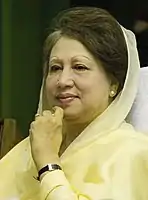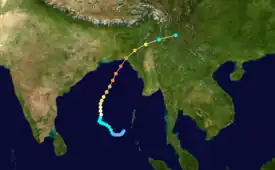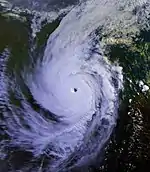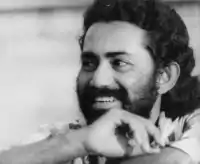1991 in Bangladesh
1991 (MCMXCI) was a common year starting on Tuesday of the Gregorian calendar, the 1991st year of the Common Era (CE) and Anno Domini (AD) designations, the 991st year of the 2nd millennium, the 91st year of the 20th century, and the 2nd year of the 1990s decade.
| |||||
| Centuries: |
| ||||
|---|---|---|---|---|---|
| Decades: |
| ||||
| See also: | Other events of 1991 List of years in Bangladesh | ||||
The year 1991 was the 20th year after the independence of Bangladesh. It was the first year of the first term of the government of Khaleda Zia.
Incumbents

Zia
- President: Shahabuddin Ahmed (acting) (until 10 October), Abdur Rahman Biswas (starting 10 October)
- Prime Minister: Khaleda Zia (starting 20 March)
- Vice President: Shahabuddin Ahmed (until 10 October); post abolished
- Chief Justice: Shahabuddin Ahmed
Demography
| Population, total | 105,599,125 |
| Population density (per km2) | 811.2 |
| Population growth (annual %) | 2.3% |
| Male to Female Ratio (every 100 Female) | 106.4 |
| Urban population (% of total) | 20.3% |
| Birth rate, crude (per 1,000 people) | 34.2 |
| Death rate, crude (per 1,000 people) | 9.9 |
| Mortality rate, under 5 (per 1,000 live births) | 138 |
| Life expectancy at birth, total (years) | 58.9 |
| Fertility rate, total (births per woman) | 4.3 |
Climate
| Climate data for Bangladesh in 1991 | |||||||||||||
|---|---|---|---|---|---|---|---|---|---|---|---|---|---|
| Month | Jan | Feb | Mar | Apr | May | Jun | Jul | Aug | Sep | Oct | Nov | Dec | Year |
| Daily mean °C (°F) | 17.4 (63.3) |
21.8 (71.2) |
26. (79) |
27.4 (81.3) |
27.4 (81.3) |
27.7 (81.9) |
28.2 (82.8) |
28.2 (82.8) |
27.4 (81.3) |
26.6 (79.9) |
22.4 (72.3) |
18.6 (65.5) |
24.9 (76.8) |
| Average precipitation mm (inches) | 13.8 (0.54) |
22.8 (0.90) |
38.8 (1.53) |
261.1 (10.28) |
372.5 (14.67) |
359.4 (14.15) |
430.8 (16.96) |
403.6 (15.89) |
516.2 (20.32) |
218.4 (8.60) |
25.5 (1.00) |
29.3 (1.15) |
2,692.1 (105.99) |
| Source: Climatic Research Unit (CRU) of University of East Anglia (UEA)[2] | |||||||||||||
Cyclone
The 1991 Bangladesh cyclone (IMD designation: BOB 01, JTWC designation: 02B) was among the deadliest tropical cyclones on record. On the night of 29 April 1991, it struck the Chittagong district of southeastern Bangladesh with winds of around 250 km/h (155 mph). The storm forced a 6-metre (20 ft) storm surge inland over a wide area, killing at least 138,866 people and leaving as many as 10 million homeless.[3]

Tropical storm (39–73 mph, 63–118 km/h)
Category 1 (74–95 mph, 119–153 km/h)
Category 2 (96–110 mph, 154–177 km/h)
Category 3 (111–129 mph, 178–208 km/h)
Category 4 (130–156 mph, 209–251 km/h)
Category 5 (≥157 mph, ≥252 km/h)
Unknown
During 22 April 1991, a circulation formed in the southern Bay of Bengal from a persistent area of convection, or thunderstorms, near the equator in the eastern Indian Ocean. Within two days, the cloud mass encompassed most of the Bay of Bengal, focused on an area west of the Andaman and Nicobar Islands.[4][5] On 24 April, the India Meteorological Department (IMD)[nb 1] designated the system as a depression, and the Joint Typhoon Warning Center (JTWC)[nb 2] labeled the system as Tropical Cyclone 02B. Ships in the region reported winds of around 55 km/h (35 mph) around this time.[8]
From its genesis, the storm moved northwestward, being gradually strengthened, amplified by a wind surge from the south. By 26 April, wind shear had decreased to near zero as an anticyclone developed aloft the hurricane. Around this time, the cyclone rounded the western periphery of a large subtropical ridge over Thailand, and the storm turned northward between the ridge to the northeast and northwest. On 28 April, the flow of the southwesterlies caused the cyclone to accelerate to the north-northeast. This flow also amplified the storm's outflow, and the cyclone intensified further. By 12:00 UTC on 28 April, or about 31 hours before landfall, the JTWC was correctly forecasting a landfall in southeastern Bangladesh.[4] Early on 29 April, the IMD upgraded the system to a super cyclonic storm – the highest category – and estimated peak winds of 240 km/h (150 mph). The JTWC estimated peak winds of 160 mph (260 km/h), the equivalent to a Category 5 hurricane on the Saffir–Simpson scale or a super typhoon. The cyclone's high winds and low pressure, a rarity for the Bay of Bengal, ranked it among the most intense cyclones in the basin. At 19:00 UTC on 29 April, the cyclone made landfall about 55 km (35 mi) south of Chittagong in southeastern Bangladesh while slightly below its peak strength. Moving through the mountainous terrain of the Chittagong Hill Tracts, the cyclone quickly weakened and crossed into northeast India, where it degenerated into a remnant low-pressure area.[9][8][4]
Economy
| National Income | |||
|---|---|---|---|
| Current US$ | Current BDT | % of GDP | |
| GDP | $31.0 billion | BDT1,105.2 billion | |
| GDP growth (annual %) | 3.5% | ||
| GDP per capita | $293.2 | BDT10,466 | |
| Agriculture, value added | $9.8 billion | BDT350.1 billion | 31.7% |
| Industry, value added | $6.5 billion | BDT233.4 billion | 21.1% |
| Services, etc., value added | $13.7 billion | BDT490.2 billion | 44.4% |
| Balance of Payment | |||
| Current US$ | Current BDT | % of GDP | |
| Current account balance | $64.6 million | .2% | |
| Imports of goods and services | $3,769.7 million | BDT135.1 billion | 12.2% |
| Exports of goods and services | $2,119.7 million | BDT73.6 billion | 6.7% |
| Foreign direct investment, net inflows | $1.4 million | 0.0% | |
| Personal remittances, received | $769.4 million | 2.5% | |
| Total reserves (includes gold) at year end | $1,307.9 million | ||
| Total reserves in months of imports | 4 | ||
Note: For the year 1991 average official exchange rate for BDT was 36.60 per US$.
Events

- 27 February – 1991 Bangladeshi general election, Bangladesh Nationalist Party emerges victorious.
- 29 April – 1991 Bangladesh cyclone kills more than 138,000.
- 10 May – President Bush directed the US military to provide humanitarian assistance to Bangladesh under the umbrella of Operation Sea Angel.[10] A Contingency Joint Task Force under the command of Lieutenant General Henry C. Stackpole, consisting of over 400 Marines and 3,000 sailors, was subsequently sent to Bangladesh to provide food, water, and medical care to nearly two million people.
- 17 July – Government raised the maximum age limit for entering government job from 27 years to 30 years.[11]
- 15 September – A constitutional referendum was held where voters were asked "Should or not the President assent to the Constitution (Twelfth Amendment) Bill, 1991 of the People's Republic of Bangladesh?" The amendments would lead to the reintroduction of parliamentary government, with the President becoming the constitutional head of state, but the Prime Minister the executive head. The result saw 83.6% vote in favour, with a turnout of 35.2%.[12]
Independence Day Award
| Recipients | Area | Note |
|---|---|---|
| Naeb Subedar Shah Alam | Sports | |
| Shamsur Rahman | Literature | |
| M Innas Ali | Science and technology |
Ekushey Padak
- Ahmed Sharif (education)
- Kabir Chowdhury (literature)
- A.F. Salahuddin Ahmed (education)
- A.M. Harun-ar-Rashid (science)
- Foyez Ahmad (literature)
- Sanjida Khatun (literature)
- Aminul Huq[13]
- Kazi Abdul Baset (fine arts)
Sports
- South Asian (Federation) Games:
- Domestic football:
- Brothers Union won Bangladesh Federation Cup title.[15]
Births
- 12 February – Shahidul Yousuf Sohel, footballer
- 29 May – Rumana Ahmed, cricketer
- 5 August – Sohag Gazi, cricketer
- 30 November – Nasir Hossain, cricketer
Deaths

- 11 March – Principal Abul Kashem, academician (b.1920)
- 31 March – Abul Kashem Khan, industrialist (b.1905)
- 23 April – Lokman Hossain Fakir, musician (b.1924)
- 21 June – Rudra Mohammad Shahidullah, poet (b.1956)
- 3 July – Dolly Anwar, actor (b.1941)
- 11 October – Golam Samdani Koraishi, author (b.1929)
- 3 December – Badruddin Ahmed Siddiky, jurist (b.1915)
- 7 December – Ataur Rahman Khan, politician (b.1905)
- 22 December – Mirza Nurul Huda, politician (b.1919)
Notes
- The India Meteorological Department became the official Regional Specialized Meteorological Center for the northern Indian Ocean in 1988.[6]
- The Joint Typhoon Warning Center is a joint United States Navy – United States Air Force task force that issues tropical cyclone warnings for the northern Indian Ocean and other regions.[7]
References
- "World Development Indicators". The World Bank. Retrieved 9 December 2021.
- "Climate Change Knowledge Portal". The World Bank Group. Archived from the original on 27 May 2018. Retrieved 27 May 2018.
- Unattributed (2008). "The Worst Natural Disasters by Death Toll" (PDF). NOAA Backgrounder. Archived from the original (PDF) on 12 July 2020. Retrieved 3 October 2018.
- Annual Tropical Cyclone Report (PDF). Joint Typhoon Warning Center (Report). United States Navy, United States Airforce. 1992. p. 155. Archived (PDF) from the original on 19 October 2016. Retrieved 7 March 2017.
- "Tropical Cyclone 02B Best Track". Joint Typhoon Warning Center. United States Navy, United States Airforce. 1 December 2002. Archived from the original on 8 December 2015. Retrieved 15 January 2015.
- Cyclone Warning Services in India (Report). India Meteorological Department. Retrieved 8 March 2017.
- Joint Typhoon Warning Center (2011). "Joint Typhoon Warning Center Mission Statement". United States Navy, United States Airforce. Archived from the original on 26 July 2007. Retrieved 30 November 2011.
- Bangladesh Cyclone, April 24–30 1991 (PDF) (Report on Cyclonic Disturbances (Depressions and Tropical Cyclones) over North Indian Ocean in 1991). India Meteorological Department. January 1992. p. 4. Archived (PDF) from the original on 31 January 2015. Retrieved 15 January 2014.
- IMD Best track data 1990–2015 (XLS) (Report). India Meteorological Department. 2015. Retrieved 7 March 2017.
- Berke, Richard L. (12 May 1991). "U.S. SENDS TROOPS TO AID BANGLADESH IN CYCLONE RELIEF". The New York Times. ISSN 0362-4331. Retrieved 29 April 2016.
- "215-Law-1991" (PDF). Department of Printing and Publications, Government of Bangladesh. Archived from the original (PDF) on 30 August 2018. Retrieved 29 August 2018.
- Dieter Nohlen, Florian Grotz & Christof Hartmann (2001) Elections in Asia: A data handbook, Volume I, p534 ISBN 0-19-924958-X
- "'Mukh O Mukhosh' hero Aminul no more..." Dhaka Mirror. 1 August 2011.
- "SOUTH ASIAN GAMES". Olympic Council of Asia. Retrieved 1 November 2018.
- "Bangladesh – List of Cup Winners". Ian King, Hans Schöggl and Erlan Manaschev for Rec.Sport.Soccer Statistics Foundation. Retrieved 30 October 2018.